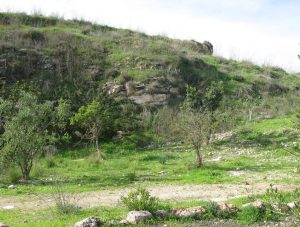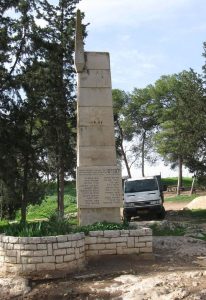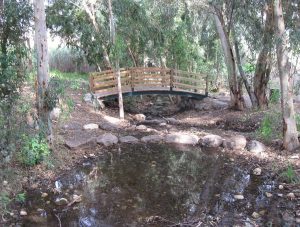Many stories in Tanakh are timeless. As much as our surroundings and comforts become more sophisticated, basic human nature stays the same, for better and often for worse. Human nature at its most venal and cruel is on display in the story of Navot’s vineyard, told in Kings I chapter 21. It would not take much to update the story to a modern setting.
Navot is a farmer with a vineyard that is part of his ancestral tribal heritage, his nahalat avot. Unfortunately for him, this vineyard abuts the property of the king, who wants it for his own:
“Ahab said to Navot, ‘Give me your vineyard, so that I may have it as a vegetable garden, since it is right next to my palace. I will give you a better vineyard in exchange; or, if you prefer, I will pay you the price in money.’ ” (Kings I 21:2)
Navot refuses to give up his land for any price. Ahab is frustrated and depressed; meanwhile his wife Jezebel finds a more creative solution. Jezebel is a princess from Zidon, in today’s Lebanon, and she has not grown up in a culture where the king is beholden to the law. Still, despite her ruthlessness, she must work within the Israelite legal framework. So she sets up a mechanism to frame Navot for treason and have him executed. And anyone who dies because he is a traitor to the king, his property is inherited by . . . the king. Problem solved:
“Then the two scoundrels came and sat down opposite him; and those scoundrels testified against Navot publicly as follows: ‘Navot has reviled Elokim and king.’ Then they took him outside the town and stoned him to death.” (Kings I 21:13)
Our Gemara quotes this story in order to determine if the “Elokim” mentioned here refers to God or to judges and/or idols.
“All names that are stated with regard to Navot are sacred” (Shevuot 35b)
After this travesty, God appears to Elijah the prophet and tells him to deliver this immortal line to Ahab as he is strolling in his newly acquired vineyard:
“Say to him, ‘Thus said God: Would you murder and take possession? Thus said God: In the very place where the dogs lapped up Navot’s blood, the dogs will lap up your blood too.’” ( Kings I 21:19)
While the messages of the story – power corrupts, God will punish the evildoer – are timeless, the tale is grounded in a specific time and place. The place is what we want to explore here. The beginning of the story tells us clearly where we are:
“Navot the Jezreelite owned a vineyard in Jezreel, adjoining the palace (heichal) of King Ahab of Samaria” (Kings I 21:1)
Today when we talk about Jezreel we usually mean the valley, an important thoroughfare between Samaria and the Galilee that is one of the most fertile and productive agricultural areas in the country. In that valley, right near the modern Kibbutz Yizrael, are two ancient tells, Tel Yizrael on the hill and Tel Ein Yizrael (the spring of Yizrael) below it. Can these sites give us insight into our story?
Tel Yizrael lies in the heart of the agricultural riches of the valley. Any king would have wanted to control the lands and the roads nearby. Ahab made himself a winter palace here. In the 1990s the tel was excavated by David Ussishkin and he uncovered a fascinating thing – towers surrounding a royal compound. The palace was well protected by the towers, a wall and a dry moat. While not as extensive and fabulous as the palaces uncovered in nearby Samaria and Megiddo, this was one of Ahab’s royal properties and he clearly spent time there as we can see at the end of the story about rain finally coming down on Mount Carmel:
“Meanwhile the sky grew black with clouds; there was wind, and a heavy downpour fell; Ahab mounted his chariot and drove off to Jezreel” (Kings I 18:45)

The remains of one of the towers of the fortress
Ori~, Attribution, via Wikimedia Commons
Yizrael was destroyed in the years after Ahab’s reign. The Crusaders built a fortress here and it was a base for them before they set out to fight Saladin in 1183. In the nineteenth century the tel was settled by local Arabs who called it Zirin. Zirin was very hostile to the Jewish communities nearby before and during the War of Independence and it was conquered and destroyed at the end of May 1948 by the Palmach. Today there is a memorial to the soldiers who fought to defend the valley.

Ori~, Attribution, via Wikimedia Commons
The fantastic view from the tel and the rich fields below help us understand why Ahab wanted a palace here. Below the tel is a green oasis, a clump of eucalyptus trees surrounding a spring, Ein Yizreel. This is where King Saul camped with his men before they set out to fight the Philistines in what would be his final battle:
“The Philistines mustered all their forces at Aphek, while Israel was encamping at the spring in Jezreel” (Samuel I 29:1)

Ori~, Attribution, via Wikimedia Commons
In recent excavations conducted by Norma Franklin, ancient remains were also found in Ein Yizrael. Among the many layers of settlement, there is one from Israelite times. One of the most intriguing finds is a large winepress, on the edge of the fields. The technology is from Biblical times, not the more sophisticated winepresses of Hellenisic times. There is a surface to press the grapes and two large vats in the ground to collect the juice. There were also remains of many smaller pottery jugs, perhaps used for adding elements to the wine.
Franklin identifies the “heichal” of Ahab at Tel Yizrael as a military fortress, a site from where Ahab could gather his soldiers and set out to battle. With many troops to feed; a vineyard and a large supply of wine would be a great asset for the king. The soil here is also well suited for growing grapes. While we cannot prove for certain that this winepress and the adjacent fields belonged to Navot, that is certainly a logical supposition.
Navot and Ahab are long gone. The rich land of the valley and the desire for it continue to this day.

Ori~, Attribution, via Wikimedia Commons










